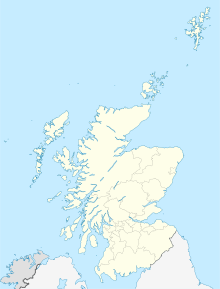Modern Two
 | |
 Location within Scotland | |
Former name | Dean Gallery |
|---|---|
| Location | 75 Belford Road, Edinburgh, EH4 3DR |
| Type | Art Museum |
| Website | https://www.nationalgalleries.org/visit/scottish-national-gallery-modern-art |

Modern Two, formerly the Dean Gallery, in Edinburgh, is one of the two buildings housing the Scottish National Gallery of Modern Art, one of Scotland's national art galleries. It is operated by the National Galleries of Scotland.
Since its opening it has housed the Paolozzi Gift, a collection of his works given to the Scottish National Gallery of Modern Art in 1994 by Sir Eduardo Paolozzi. It contains a large collection of Dada and Surrealist art and literature, much of which was given by Gabrielle Keiller. It is also used for temporary exhibitions.[1]
The Dean Gallery is twinned with Modern One which lies on the opposite side of Belford Road.
Building history[]
The building was a replacement for the Orphan Hospital, built 1734 on ground owned by Trinity College Kirk on Leith Wynd in the valley between the High Street and Calton Hill, to make way for the construction of Waverley Station.
The building, known as the Dean Orphanage, was designed by Thomas Hamilton in 1831 and took three years to build. Built in Craigleith stone from the nearby quarry, it is in English Baroque style with classical detail. The towers over the staircases contain chimneys and contribute to the Edinburgh skyline in the west of the city centre. The clock above the entrance comes from the original Orphan Hospital and in turn from the 1764 demolition of the Netherbow Port on the High Street, which formerly separated the High Street from the Canongate.[2]
The building, which is owned by the City of Edinburgh Council, served as the Dean Education Centre for many decades before conversion to a gallery.
The plot of allotment gardens at the main entrance dates from 1940 when many school grounds were used for such purposes.
Why is the Building so Grand?[]
It astounds most people that this magnificent building set in huge grounds was built as an orphanage as it looks like the finest of country palaces.
The principle person responsible appears to be James Bonar WS. He was an elder at Lady Glenorchy's Church which stood in the grounds of the original orphanage. When the idea of a new railway station in Edinburgh, requiring the demolition of both the orphanage and the church, arose in the early 1830s, he contrived a plan, along with his church patron, Lady Glenorchy, to combine her funds with the compensation from the railway company (ensured in an Act of 1836) to build a very generous new orphanage in the clean country air, west of the city. The Lord Provost, John Learmonth, was pulled into the idea around 1833, and he agreed to gift the land required for the project. He was however partially using this philanthropic gesture as a carrot to his fellow town councillors to allow development of the remaining land for housing (the area now known as Learmonth). Bonar appears to have also provided funds himself, either on a permanent basis, or as a bridge while awaiting the railway compensation. The result was a building costing at least double what the original expected budget was. This allowed for a truly well-built building in dressed ashlar sandstone, with two feature bellcotes.[3]
Conversion to gallery[]

The conversion of the building into a gallery was designed by the architect, Terry Farrell and Partners.[4]
The gallery opened in 1999 opposite the existing Scottish National Gallery of Modern Art. In a rebranding exercise in 2011, the buildings were renamed Modern Two and Modern One respectively.
References[]
- ^ "National Galleries of Scotland - Online Collections". 5 November 2006. Archived from the original on 5 November 2006. Retrieved 29 October 2018.
- ^ Buildings of Scotland: Edinburgh, by Gifford McWilliam and Walker
- ^ Grant's Old and New Edinburgh vol2
- ^ "The History of the Scottish National Gallery of Modern Art". www.nationalgalleries.org. Retrieved 12 February 2021.
External links[]
Coordinates: 55°57′06.52″N 3°13′26.75″W / 55.9518111°N 3.2240972°W
- Culture in Edinburgh
- Dada
- National Galleries of Scotland
- Category A listed buildings in Edinburgh
- Art museums and galleries in Edinburgh
- Modern art museums
- Art museums established in 1999
- 1999 establishments in Scotland
- Literary museums in Scotland
- Listed museum buildings in Scotland
- Surrealism
- Scottish contemporary art
- National galleries
- Scotland government stubs
- United Kingdom art museum and gallery stubs
